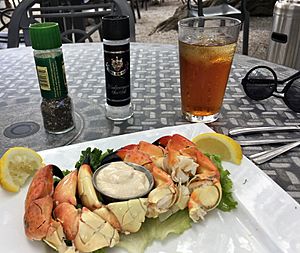Declawing of crabs facts for kids
Declawing of crabs is when one or both of a crab's claws are carefully removed by hand. This happens in the fishing industry around the world. After their claws are taken, the live crabs are put back into the water.
Crabs can often regrow their lost limbs over time. Because of this, some people think declawing is a more eco-friendly way to fish. However, it takes a long time for a crab to regrow its claws. Scientists are still studying if this practice is truly sustainable. There are also debates about whether crabs feel pain during this process.
Even though declawing doesn't always kill the crab, it can make it harder for them to survive in the wild. Declawing is a debated practice. Some places have completely or partly banned it. Other places only allow crab claws to be caught for sale.
Contents
How Crabs Are Declawed
Declawing is done by hand. To make sure the claw breaks cleanly, a person places a finger on the crab's claw joint. Then, they quickly push the claw downwards when it is fully stretched out. This breaks the claw at a natural weak point near the base of the leg.
Declawing is popular for crabs whose whole bodies are not eaten by people. Removing the claws makes it easier to store and move crab meat. It also stops crabs from eating each other in storage tanks. Plus, it makes the crabs easier for the fishing crew to handle.
Rules for Declawing Crabs
Rules about crab fishing are different all over the world. They depend on the region and the type of crab. Not all crabs caught are declawed. For example, the United Kingdom banned declawing for 14 years, from 1986 to 2000.
In the United States, different states have their own rules. Rules for Alaskan king crab fishing don't mention declawing. They assume the whole crab will be caught. Some states like Florida and Louisiana only allow declawing for Florida stone crab. They do not allow catching the whole stone crab. But in Maryland, declawing Jonah crab was banned after 2015. There was an exception for boats that had always done it and were registered in a state where it was allowed.
Is Declawing Sustainable?
The main idea behind declawing is that it's more sustainable. This is because crabs can regrow their lost claws. But claws are a big part of a crab's body weight. They can be 20% to over 50% of some crabs' total weight. Regrowing a claw takes a lot of energy and time.
Studies show that very few regenerated claws are found in catches. For stone crabs, studies found less than 10% to 13% of claws were regrown. Older, larger crabs often don't live long enough to regrow their claws. This is because they are already near the end of their lives.
How Declawing Affects Crabs
Crabs that survive declawing might have trouble finding food, mating, and defending themselves. The biggest risk right after declawing is death. In one study, 47% of Florida stone crabs died after both claws were removed. Also, 28% of crabs with one claw removed died. Most of these deaths happened within 24 hours.
Declawing also makes it harder for crabs to eat. Crabs usually use their claws to catch and eat their prey. Declawed stone crabs have to scavenge for food instead of actively hunting. In experiments, declawed stone crabs ate the same amount of food. But they changed what they ate. They ate fish instead of bivalves, which are usually a big part of their diet. This is because bivalves need to be opened with a strong claw. In the wild, where declawed crabs must compete for food, starvation is a big danger. Research on Jonah crabs found that declawed crabs were much more likely to refuse food completely.
Also, declawed crabs are much less active. They may also have trouble attracting mates. One study showed that brown crabs that lost their own claws (called autotomy) mated better than crabs that were manually declawed. The manually declawed crabs were much less likely to attract females. The effects on mating can be different for different crab species. Studies on the green crab and the velvet crab show that losing limbs hurts their chances of mating. However, for the Atlantic blue crab, the evidence is mixed.
Do Crabs Feel Pain?
Scientists are still discussing whether crustaceans can feel pain. Some people argue that because crabs can drop their own claws (autotomize), removing them along natural break lines might not cause pain. However, one study found that declawing caused more stress in crabs than when they dropped their own claws. This was measured by looking at their body responses.


